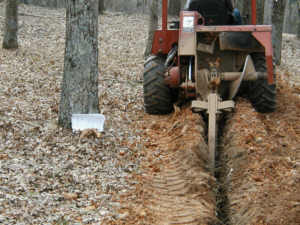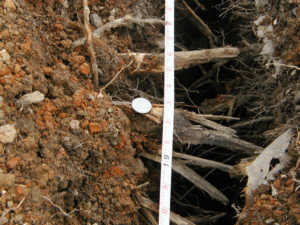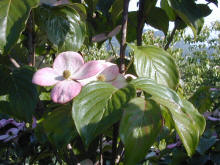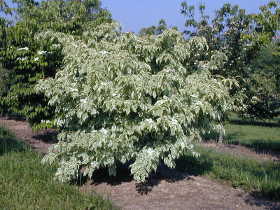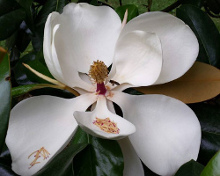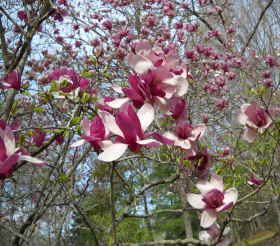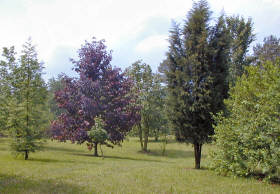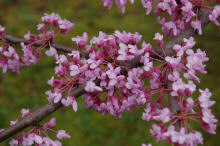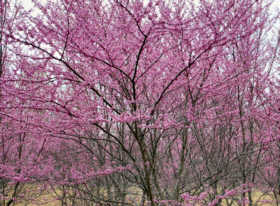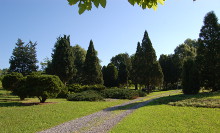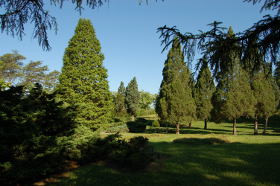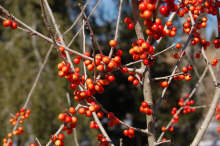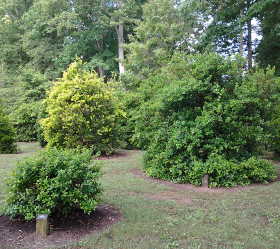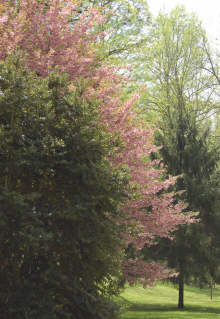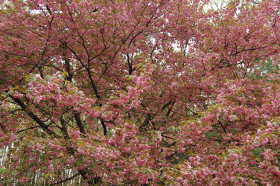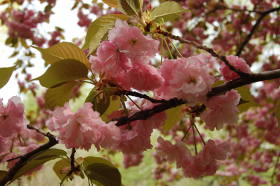
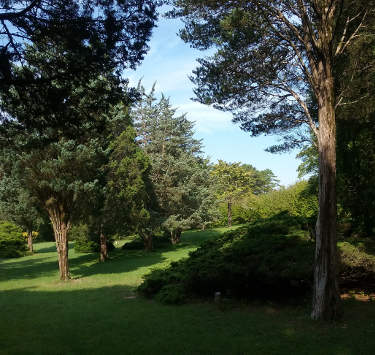
Urban Forestry… the art, science, and technology of managing trees and forest resources in and around urban community ecosystems for the physiological, sociological, economic, and aesthetic benefits trees provide society.
This guide was built upon a demonstration project conducted at the UT Arboretum. The project was designed to demonstrate urban forestry practices and to lay an initial foundation for promoting and heightening awareness of urban forest stewardship. Click on the links below to read tips, techniques, and best practices for an urban setting that resulted from this project.
- Backyard wildlife conservation techniques
- Invasive exotic plant control
- Managing urban woods
- Tree planting techniques
- Tree pruning and maintenance
- Construction damage impacts
- Trees for urban landscapes
Backyard wildlife conservation techniques
You can enjoy wildlife in your own yard if you create a good habitat, or home, for birds and other wildlife. Such a habitat depends on three important things: FOOD, SHELTER, and PROTECTION. By improving any or all of these things, you can enhance opportunities to view wildlife and help conserve the species.
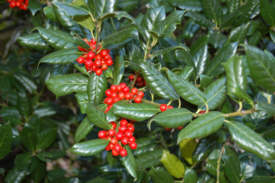
Backyards with mixtures of trees, shrubs, seed-bearing flowers, and grasses are inviting to wildlife.
The following trees are good food sources: oaks, dogwoods, white pine, holly, junipers, red cedar, hawthorne, crabapple, and beech.
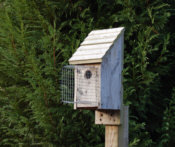
Artificial nesting and feeding structures for birds and mammals can provide instant benefits for wildlife. There are hundreds of clever and intriguing designs for wildlife structures which are effective and beautiful additions to any backyard.
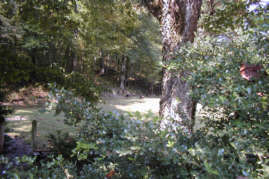
Plants can offer protection as well as food for wildlife. When designing a landscape include: plants of varying heights, locations for perching and roosting, cover in the winter, and thickets of thorny plants.
Invasive exotic plant control
Invasion of nonnative plants into rural and urban forested landscapes can have devastating effects on natural ecosystems and biodiversity. These plants displace native species and upset the natural associations between plants and animals. Invasive exotic plants occur as trees, shrubs, vines, grasses, ferns and forbs. Many of the invasive exotic plants within the Arboretum have spread from farmstead homes previously found throughout the area.
The Arboretum has taken active measures to eliminate or control the spread of nonnative invasive plants such as those listed below and to promote the use of non-invasive alternative plants.
All images are from the publication “Invasive Plants of the Eastern United States CD-ROM.” The photographer is listed with the individual images.
Silktree, Mimosa
(Albizia julibrissin)
James H. Miller
USDA Forest Service
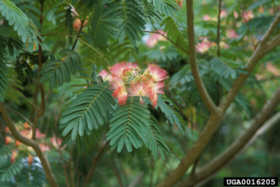
Chinese Privet
(Ligustrum sinense)
Ted Bodner
Southern Weed Science Society
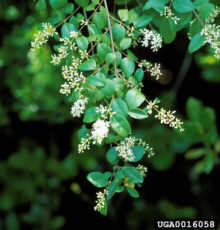
Japanese Privet
(Ligustrum japonicum)
J. S. Peterson
USDA-NRCS Plants
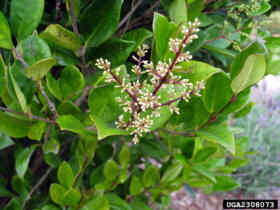
Princesstree, Paulownia
(Paulownia tomentosa)
James H. Miller
USDA Forest Service
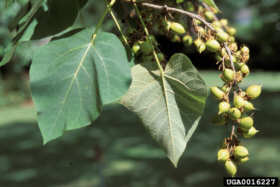
Japanese knotweed
(Polygonum cuspidatum)
Jack Ranney UT
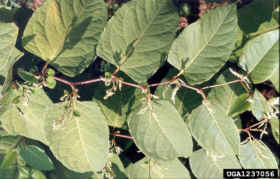
Winter Creeper
(Euonymus fortunei)
James H. Miller
USDA Forest Service
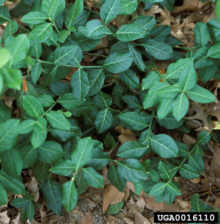
Kudsu
(Pueraria montana)
David J. Moorhead
University of Georgia
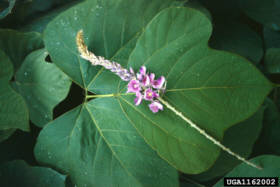
Oriental Bittersweet
(Celastrus orbibulatus)
James H. Miller
USDA Forest Service
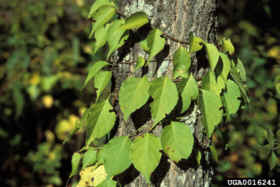
English Ivy
(Hedera helix)
Chuck Bargeron
University of Georgia
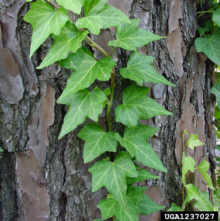
Purple Crownvetch
(Coronilla varia)
Dan Tenaglia
missouriplants.com
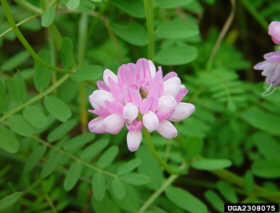
Japanese honeysuckle
(Lonicera japonica)
Chuck Bargeron
University of Georgia
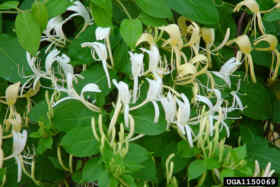
Orange Daylily
(Hemerocallis fulva)
Dan Tenaglia
missouriplants.com
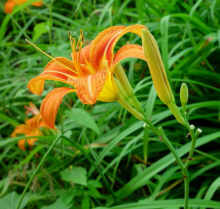
Common Periwinkle
(Vinca minor)
Dan Tenaglia
missouriplants.com
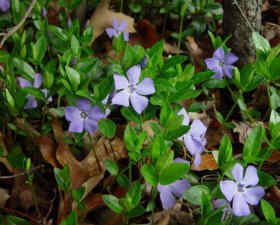
Multiflora Rose
(Rosa multiflora)
David J. Moorhead
University of Georgia
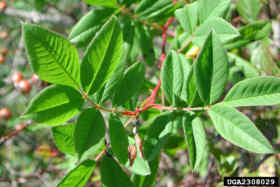
Managing urban woods
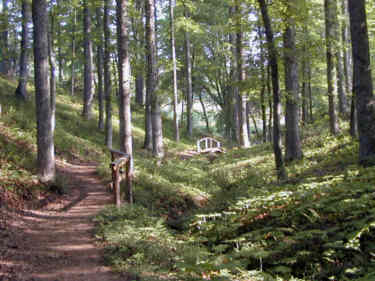
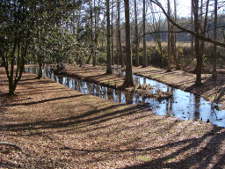
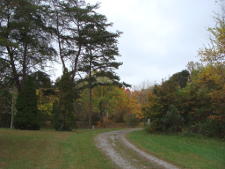
Many cities and towns have areas that have been designated open space, common, or green areas. These areas are typically intended to be left in a “natural state”. This definition has many meanings to residents and governments – from “do not disturb” to “manicured”. Most residents and governments have agreed upon something in between wherein lies the need for some type of management of the area, which typically includes woods.
The grounds of the UT Arboretum provide an opportunity for people responsible for maintaining the green areas in cities and towns to see woods management in action. In addition to being a teaching and research facility, the Arboretum is also a “natural” area that exhibits desirable forest management practices.
The Heath Cove along the upper and lower Heath Cove Trail is one of the designated Woods Management areas.
Urban woods management includes proper care of wetlands as in the photo at left and also an aesthetically pleasing area for walking enjoyment as in the photo at right.
Tree planting techniques
Urban Planting
Choosing a tree
Most trees are “rated” for their ability to flourish in various climates called “plant hardiness zones”. This information can sometimes be found on the nursery tag or in reference books. Choose a tree that is known to survive in your zone. The Arboretum is located on the boundary of plant hardiness zones 6b and 7a.
When to plant
Newly planted trees do best when exposed to moderate temperature and rainfall. Give them time to root and adjust before the intense heat and dryness of summer or the freezing temperatures of winter. Spring and early fall are generally the best planting seasons (depending on your location) with fall preferred in the more southerly latitudes.
Tennessee Hardiness Zone Map

Average coldest winter temperature


Arboretum Tree Mulching Demonstration
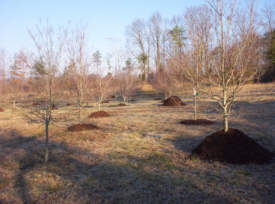
Proper mulching application should be no deeper than 3 – 4 inches. A tree mulching project which tested the long-term effect of proper and improper tree mulch application was conducted at the Arboretum. Mulch was applied in mounds of 3, 6, 12, and 24 inches. The purpose of this research was to demonstrate the benefits of applying mulch properly and to identify the adverse effect of piling mulch too high around the stems.
Types of Trees
Trees purchased from wholesale and retail nurseries and garden supply stores generally come in one of three forms.
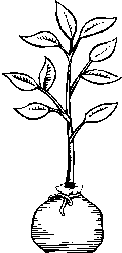
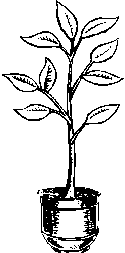
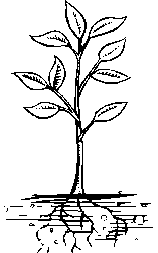
Planting Tips
Digging the Hole As a general rule, trees should be transplanted no deeper than the soil in which they were originally grown. Trees planted too deep or to shallow may develop unnaturally, have weakened root systems, and grow poorly. The hole should be wide enough to allow the root structure to expand sufficiently to nourish and properly anchor the tree.
B & B Planting Remove all string and twine from B&B trees and cutaway burlap or at least bulled-back from the top third of the ball (mandatory in the case of synthetic or plastic burlap).
Container Grown Planting Carefully remove from the container and check the roots. If they are tightly compressed or potbound, use your fingers or a blunt instrument (to minimize root tearing) to carefully tease the fine roots away from the tight mass and then spread the roots prior to planting.
Bare Root Planting Plant as soon as possible after purchasing. Care should be taken to ensure that the roots are kept moist in the period between purchase and planting. To plant, first build a cone of earth in the center of the hole around which to splay the roots. Make sure that when properly seated on this cone the tree is planted so that the trunk flare is clearly visible and the crown, where the roots and top meet, is about two inches above the soil level. This is to allow for natural settling.
Watering Newly planted trees should be watered at the time of planting. In addition, during the first growing season, they should be watered at least once a week in the absence of rain, more often during the height of the summer. However, care should be taken not to overwater as this may result in oxygen deprivation.
Mulching To conserve moisture and promote water and air penetration, the back filled soil surrounding newly-planted trees can be covered with mulch consisting of material such as bark, wood chips or pine needles (although the acidity associated with pine needles is not suited for many plants). Mulch depth should be between 3 to 4 inches.
Fertilizing Generally, newly planted trees do not need to be fertilized the first year they are planted. During that first year plants are re-establishing root-to-soil contact and the addition of fertilizers may stimulate tree growth before the root system is fully developed to support or sustain growth. This may be a particular problem with B&B trees which have some of their root systems removed during digging.
Staking and guy-wiring Staking may be necessary for some newly planted trees while they are establishing a root system capable of supporting their own weight. Only stake a tree long enough to stand on its own. Leave room for the tree to sway in the wind but not rub against the stake.
Wrapping A technique of winding a crepe-type paper or spiral plastic around the barks of trees to prevent the sun-scalding of thin-barked trees like soft maples and crabapples during the first one or two winters after planting. Remove the wrapping each spring to prevent moisture buildup, disease and insect infestation.
Tree pruning and maintenance
Shade trees need care and maintenance to remain healthy and structurally sound, to have a pleasing appearance, and to prolong their useful life. Pruning is one of the most important of all tree maintenance practices.
Various pruning schemes that are either commonly practiced or have application in specific circumstances are shown below. There are also three practices included that may cause harm to the long-term health of a tree.
Tree “A” – Pin Oak
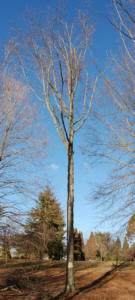
Crown Reduction/Shaping
A pruning application to reduce tree height and crown size. Primarily used to lessen wind stress. Used selectively on trees judged to be a hazard in high wind conditions.
Pruning techniques:
1. Limbs cut back to major lateral branch
2. Removal of dead branches
3. Removal of minor branches
4. Crown height raised (lower branches cut)
5. Reduction of overall crown size.
Tree “B” – Pin Oak
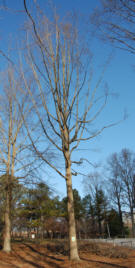
Lion’s-tailing
A pruning practice perceived to improve appearance but may be harmful to the long-term health of the tree.
Pruning techniques:
1. Removal of dead branches
2. Removal of weak branches
3. Removal of all secondary branches from major limbs, except those at the ends of the limbs – “lion’s tails”.
Potential harm in Lion’s-tailing:
1. Limbs become weak and may break
2. Increased sunlight on interior limbs may cause sun scald
3. Increased weakly attached new growth in interior portion of crown
4. Removal of too much foliage which disrupts growth
5. Modification of tree’s appearance which may reduce its value.
This is NOT a recommended practice!
Tree “C” – Pin Oak
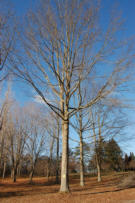
Crown Cleaning, Thinning, and Raising
Maximum/full pruning care to improve both tree health and appearance.
Pruning techniques:
1. Removal of dead, dying, diseased, and weakened branches
2. Removal of selective branches to improve light penetration, air movement, and reduce weight
3. Removal of crossing and rubbing branches
4. Crown height raised by removing lower limbs.
Tree “D” – Pin Oak
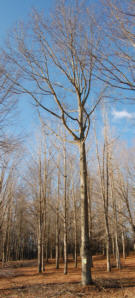
Crown Cleaning
Minimal pruning care to improve tree health.
Pruning techniques:
1. Removal of dead, dying, and diseased branches
2. Removal of weak branches.
Tree “E” – Sugar Maple
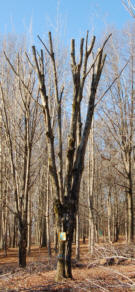
Topping
A common pruning application to reduce tree size. This practice is judged to be severely damaging to the long-term health of a tree.
Potential harm with topping:
1. Removal of the crown which upsets the root-to-crown ratio, limiting the tree’s ability to sustain its own roots
2. Large wounds which promote decay
3. Limbs weakened by decay which cannot handle the weight of rapid regrowth
4. Excessive removal of foliage disrupts the tree’s energy production and storage.
This is NOT a recommended practice!
Tree “F” – Sugar Maple
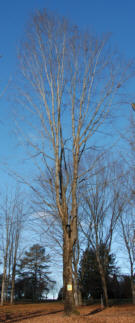
Crown Cleaning, Thinning, and Raising
Maximum/full pruning care to improve overall tree health and appearance.
Pruning techniques:
1. Removal of dead, dying, diseased, and weakened branches
2. Removal of selective branches to improve light penetration, air movement, and reduce weight
3. Removal of crossing and rubbing branches
4. Crown height raised.
Tree “G” – Sugar Maple
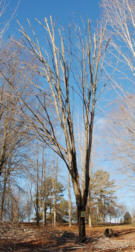
Crown Round-Over
A pruning practice used to shape tree’s upper crown and reduce height; a practice perceived to enhance aesthetics. Similar to topping but less extreme.
Potential harm in crown round-over:
1. Unnatural appearance of tree
2. Branches lacking a terminal leader because they are pruned back (hedged) indiscriminately.
This is NOT a recommended practice!
Tree “H” – Sugar Maple
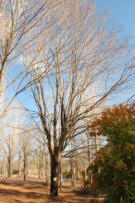
Light Crown Cleaning, Thinning and Raising with Cable Bracing
Full pruning care to improve overall tree health and appearance, with addition of cable bracing to stabilize weak branches.
Cable Bracing:
This tree’s growth characteristics include branches that are attached at a sharp angle causing acute forking. This condition can cause the limbs to split away or apart. Cable bracing overcomes this weakness by giving extra support so that the useful life of the tree can be extended.
Construction damage impacts
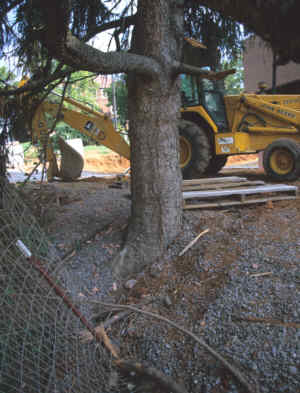
As urban areas expand, many residential and commercial sites are being developed in the midst of trees to take advantage of aesthetics and environmental value of wooded lots. Unfortunately, the processes involved with construction can harm trees nearby. In the extreme case, trees may immediately die, or they can decline over a period of years. Taking the right measures to preserve the health of these trees can add value to wooded property.
Trees, like the one above, can be damaged by physical wounds or environmental changes that impact the trunk, crown, roots, or whole tree. Physical wounds, such as a wound to the trunk or limb that is broken out, are usually apparent; however, less apparent are wounds to the roots caused by trenching, grading and digging. Environmental changes, such as adding fill-dirt over thr roots, paving, or compacting the soil may not be so apparent but can kill a tree over time. The act of removing unwanted trees on wooded lots changes environmental conditions for remaining trees, exposing them to excessive wind and sun which could cause wind-throw or sun-scalding. The ability to repair construction damage is limited.
The single most important measure a homeowner can take is to set up construction fencing (a no disturbance zone) around all trees they want protected. Allow one foot of space for each inch of trunk diameter.
Trenching Damage Demonstration
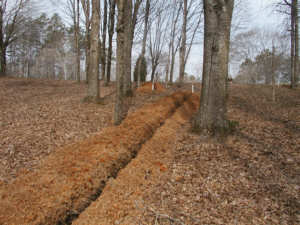
Eighty-five percent of a tree’s root system is within 18-inches of the surface. The tree plots in the demonstration were part of a research project designed to determine the effects of “trenching” too close to shade trees.
For this research there were ten shade tree groves which were “trenched” to simulate a common construction practice. The trenches were 3 feet deep, 6 inches wide, and ran in a straight line between the white poles scattered throughout the site. The groves contained Sugar Maple, Pin Oak, or Ginkgo trees, and there were similar numbers of each species represented within the tests. The amount of tree root damage varied with the distance of the trench from the base of the tree. This treatment was designed to determine the effects of trenching near shade trees and, for the long-term health of the tree, how close is too close to dig a trench.
Trees for urban landscapes
The UT Arboretum hosts many research studies on various trees suitable for urban landscapes. Visitors can follow the studies in progress and also see the results of past research projects. Areas for viewing include the Tulip Poplar Trail which encompasses the conifer, shade tree, and dogwood studies; Arboretum Drive near the Program Shelter; and the Marsh Area.
This project was supported by an Urban Forestry Grant from the USDA Forest Service and the Tennessee Department of Agriculture, Forestry Division.
